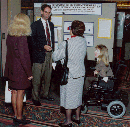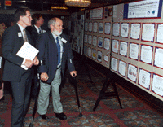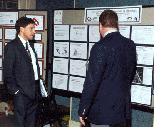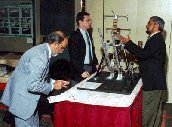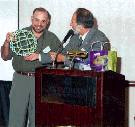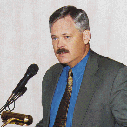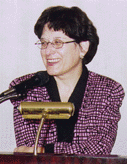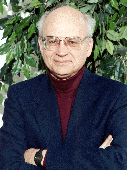
Dr. Childress
|
A series of talks from leaders in Rehabilitation Research
priority areas such as prosthetics, spinal cord injury,
communication and sensory disorders, and aging engaged the
audience in an overview of the past, present, and future.
Dr. Dudley S. Childress, Director of Prosthetics Research
Laboratory in Chicago, opened the session with a scholarly
review of the field of prosthetic design research, and the
history of its evolution within the Department of Veterans
Affairs. |
Dr. Childress emphasized that "the field was
mobilized by the consequences of World War II, and VA
support lead to America becoming a world leader in
prosthetics". The push from VA researchers
revolutionized the field of prosthetics. "Prosthetic
research and development is probably the longest running
medical research program in the VA."
Dr. Pamela Duncan, from the VA heartland Network and
University of Kansas addressed the challenges facing VA
rehabilitation researchers who are investigating issues
relevant to the aging veteran population. She noted the high
prevalence of hypertension, stroke, diabetes, and heart
disease in veterans over 64 years of age. Dr. Duncan
suggested that we could enhance quality of life more
effectively for this growing population through
multi-disciplinary evaluative, diagnostic, and therapeutic
interventions that enhance restorative and rehabilitative
care.
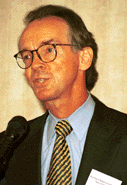
Spinal cord injury (SCI) research
opportunities,
particularly in this age of managed care, were discussed by
Kristjan Ragnarrson, MD, from Mount Sinai Medical Center in
New York. Dr. Ragnarrson applauded VA research efforts that
have led to longer, healthier, and more enjoyable lives for
veterans with SCI. Future efforts, he suggested, should be
directed toward improving neurological function, quality of
life, and especially community reintegration. Dr. Ragnarrson
also made an appeal for the practice of Evidence Based
Medicine within rehabilitation medicine. "We all
believe that rehabilitation works, but we do not understand
what ingredients in the rehabilitation process are most
effective, how much of each treatment needs to be provided,
and how long the treatment needs to be provided to achieve
optimal benefits," he noted.
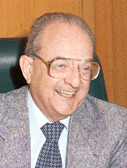
Jerome Schein, PhD, Professor Emeritus of Sensory
Rehabilitation at New York University, proclaimed the
efforts of researchers in communication, sensory and
cognitive aids as "heroic". "The last two
decades have seen copious examples of the value of VA
RR&D-funded research. Veterans have benefited from the
efforts made by a legion of scientists who might not have
contributed the wonderful array of devices, techniques and
clinical strategies we have today without VA RR&D's
support."
The highlight of the meeting was the presentation of the
inaugural Paul B. Magnuson Award for Outstanding
Achievement in Rehabilitation Research and Development.
The award is named after Dr. Paul B. Magnuson, former VA
Chief Medical Director from 1948 to 1951, who was the key
architect of the VA Health System's university affiliations,
residency programs, and a leading proponent of "Title
38" legislation that enabled VA to hire physicians and
nurses. Dr. Magnuson was also an innovative bone and joint
surgeon who founded the Rehabilitation Institute of Chicago.
With the establishment of this award, VA Rehabilitation
Research Service recognizes and honors investigators who,
like Dr. Magnuson, display genuine dedication to veterans
and whose work has significantly changed the lives of
persons with disabilities for the better.
|
The inaugural Magnuson Award was given to Dr. Ernest
Burgess by Dr. Thomas Garthwaite, Deputy UnderSecretary for
Health as "a tribute to Dr. Burgess's career of service
to veterans with amputations." A veteran of World War
II, Dr. Burgess is best known for his development of the
VA-Seattle foot and introduction of CAD-CAM into the
prosthetic fitting process. Because of Dr. Burgess' work,
many amputees not only walk today, they run. In his
acceptance speech, Dr. Burgess eloquently paid tribute to
VA's efforts to provide the best possible rehabilitation
services to veterans with prosthetic and orthopedic needs
and pressed the gathered investigators to "do
more".
|
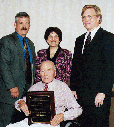
Seated: Ernest E. Burgess, MD; standing, L to R: Jophn R.
Feussner, MD; Mindy L. Aisen, MD, and Thomas Garthwaite,
MD.
|
|
Meeting Co-Chairs
|
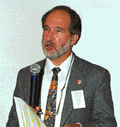
Felix E. Zajac, PhD, Rehab R&D Center and Stanford
University, Palo Alto, CA
|
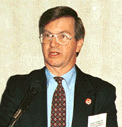
P. Hunter Peckham, PhD, VA Rehab Center of Excellence in
FES and Case Western Reserve
University, Cleveland, OH
|
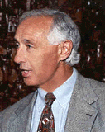
Jon S. Peters, MS, PT, Director,
Baltimore Rehabilitation Information and
Technology Administrative Center (BRITAC),
Baltimore, MD
|
This first annual meeting of VA
rehabilitation researchers was a success on all levels. In
summarizing the meeting, investigators were challenged to
focus research efforts on identifying, treating, and
preventing complications of chronic impairments, and to seize
the research opportunities inherent in refining the
applications of compensatory rehabilitative treatment
strategies. New areas of focus include upper extremity
prosthetics, visual impairment, traumatic brain injury,
Parkinson's disease, repair of damaged neural tissue, and
restoring function in veterans with conditions such as
stroke, multiple sclerosis, and spinal cord injury. Perhaps
most importantly, VA Rehabilitation Research has established
a new tradition to foster communication and collaboration
among investigators; to formally recognize the superior
achievements of rehabilitation researchers; and to redouble
efforts and refocus research results to most effectively
enable veterans into the next millenium.
Go to TOP.
